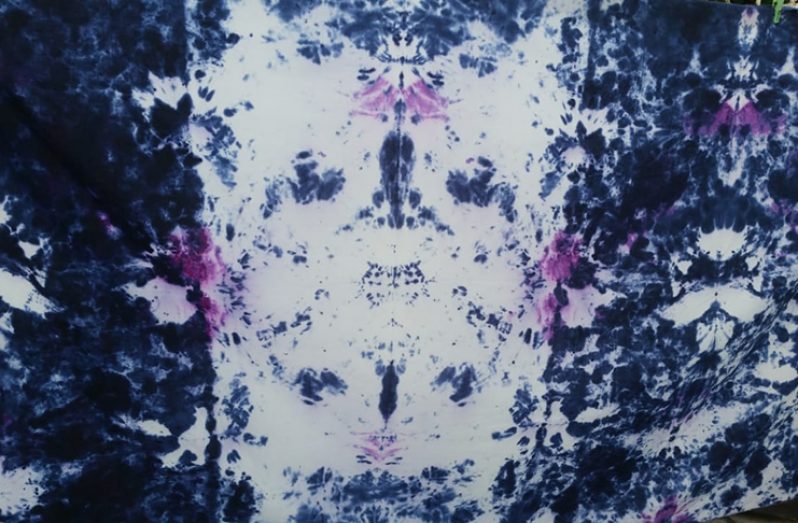By Gibron Rahim
AS human beings, we appreciate beauty in all its forms. Even as we appreciate that beauty, we may fail to realise the thought and dedication that goes into creating each piece of art. Tie-dye and fabric design artisans utilise their creativity to diligently produce wearable pieces of art.

Patricia Helwig possesses numerous artisanal skills and fabric design is among them. She related to the Pepperpot Magazine that she always loved tie-dye while she was growing up. Tie-dye would periodically feature among her pursuits as she grew older. However, it was in 1996 while she was in her final year at the University of Guyana that her interest really took off. Just after exams had wrapped up in May, she went to pursue a summer course in tie-dye with Myrna Lee (then Quamina). Helwig recalled that the course was hosted at the premises of Raphael’s Real Estate on Charlotte Street.
After completing the course, Helwig continued to work on developing her skills in the technique. “Then, in 1999, I started teaching craft – florals, fabric design, cake decoration and so on,” Helwig said. She explained that tie-dye was included within fabric design. Helwig contacted a student from the E.R. Burrowes School of Art who taught her the advanced tie-dye techniques, such as batik and hand painting, which she subsequently taught her students. “To me, every time you teach, you develop yourself more,” she affirmed. “Every time you do it you get better.”
Helwig has taught both elementary and advanced fabric design. “I don’t say tie-dye, I say fabric design,” she noted, explaining that the term includes tie-dye but also encompasses the more advanced techniques of batik and hand painting.
In 2010, Helwig began designing tie-dyed fabrics for commercial sale. She also designs African-inspired clothing and creates African head wraps. Tie-dye, she related, sometimes ties into those endeavours. In fact, she has found herself increasingly producing more tie-dyed pieces. “For this year, persons have said to me ‘tie-dye is coming in again’,” she related. Helwig has consequently invested in materials and is currently working on creating pieces whenever she has spare time. She folds, dyes and hangs pieces to dry on successive days.
There are various methods of accomplishing the wide array of patterns that tie-dye is known for. Helwig noted that there are basic patterns, including swirls, stripes, triangles, diamonds, and circles, which are accomplished using their respective techniques. There are also techniques like clumping and ruching. “Those are the basics when you’re doing the elementary [tie-dye],” she said.
Advanced tie-dye boasts even more techniques. “You have more advanced patterns that you can do and ones where you can use four or five different colours,” explained Helwig. These advanced methods include shibori, which originated in Japan and just by itself can be used to create numerous patterns. Helwig herself often uses multiple colours for the pieces she creates for sale, noting that the method allows for each individual’s work to stand out. The technique she uses to accomplish those patterns is a trade secret.
When it comes to tie-dye, not just any type of fabric will do. “For tie-dying the best fabric is cotton,” said Helwig. Silk and linen can also be used since they, like cotton, are natural fibres. “The natural fibres, more or less, take the dye,” she related. The dye simply runs off synthetic fabrics like polyester and rayon. “The best fabric [for tie dye] is 100 percent cotton.”

Selecting the correct type of fabric is only part of the battle when tie-dying. It is advisable that persons attempting to tie-dye know how to distinguish between colours and understand which colour combinations lead to the desired result. The desired shade can be achieved, “Once you know the primary, the secondary and the tertiary colours,” said Helwig. She noted that it is important to know which colours should not be mixed to avoid mud-coloured results.
There are two options when it comes to dye-hot water dye and cold water dye. “Lots of people use the hot water dye because it’s faster,” explained Helwig. “You tie but you can’t use rubber bands when you’re using the hot water dye.” Materials such as fabric or straw are instead used as ties. Proportions are used to determine how much dye must be used given the length of fabric being dyed. Proportions also dictate how much salt should be added. Once the fabric is added, “You boil it for half an hour or an hour.” A washing machine can also be used. Helwig related that the washing machine is set to its warmest water setting, with the dye and fabric then added and the tumbling motion of the washing machine helping to set the dye.
The use of cold water dye requires more patience. The pattern is folded and the fabric is left for at least six hours. “Or preferably 24 hours, preferably 48 – it depends on you,” said Helwig. “For me, the longer the fabric is in the cold dye, the longer the pattern keeps and your dye will not run.” It is important, she emphasised, to know how to properly dye the fabric but she said that not everybody who attempts to tie-dye does so properly. “I have jerseys that I dyed since 1996 and if you see them you would think I just dyed them,” she related.
Tie-dye allows artisans much creative freedom. It also grabs the attention of those with an eye for it. “It depends on how persons feel,” said Helwig. Individual people perceive different images in tie-dyed pieces. “Once you have an eye for craft and you look at it you might see a face, a sun, an animal, it depends.” Tie-dye, Helwig acknowledged, is not for everyone. “You have got to have a love for it and you have got to understand it,” she stated. “You must be appreciative of it to understand it.”



.jpg)









